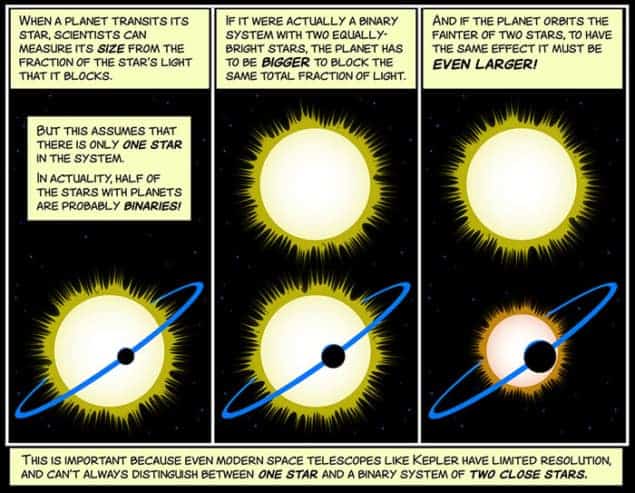
A significant number of known exoplanets could have larger diameters than previously thought, according to two astronomers in the US. These exoplanets orbit stars that are in a binary system with another star – and it is light from this companion star that has thrown off previous measurements. The work suggests that some known exoplanets are less dense than previously thought, which means that they resemble Jupiter, rather than Earth.
Many of the exoplanets discovered by the Kepler space telescope and other instruments orbit stars in binary systems. It can be difficult to differentiate between the two stars in such systems – which can appear as a single point of light. This is a problem if the exoplanet is studied using the transit method whereby the diameter of the planet relative to that of its star is determined from how much starlight it blocks when it passes between Earth and the star. Astronomers can inadvertently be measuring extra light from the companion star, which means that the measurement yields a smaller diameter for the exoplanet than its actual value.
Large errors
If the exoplanet orbits the brighter of the two stars in a binary system, then the measurement error is small. If the binary stars are the same brightness, the error is about 40% – and can be even larger if the exoplanet orbits the dimmer of the two stars.
The diameter is then used to calculate the density of the exoplanet, which determines whether it is a dense, rocky body like Earth or a gaseous planet like Jupiter. The diameter of the planet is also used to work out how closely the exoplanet orbits its star, which determines whether it lies within the habitable zone where liquid water and life could exist.
Elise Furlan of Caltech and Steve Howell of NASA Ames Research Centre looked into the extent of this problem by looking at Kepler data from 50 exoplanets that had already had their masses and diameters calculated. All of the exoplanets’ stars are in binary systems, but this had only been previously accounted for in seven cases.
Unknown orbit
Furlan and Howell worked out that 35 of the exoplanets orbited the larger star in their binary systems – which meant that their calculated sizes did not change significantly. For the other 15, they were unable to determine which star the exoplanet orbited. Five of these are in systems with stars of similar brightness, suggesting the exoplanets are 40% bigger than previously thought.
“Our understanding of how many planets are small like Earth, and how many are big like Jupiter, may change as we gain more information about the stars they orbit,” says Furlan. “You really have to know the star well to get a good handle on the properties of its planets.”
Howell adds: “In further studies, we want to make sure we are observing the type and size of planet we believe we are.” He adds: “In the big picture, knowing which planets are small and rocky will help us understand how likely we are to find planets the size of our own elsewhere in the galaxy.”
The research will be described in the Astronomical Journal and a preprint is available on arXiv.



